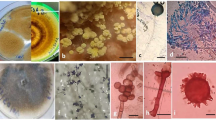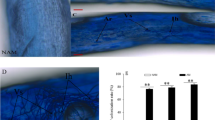Summary
Wheat plants (Triticum aestivum) grown in pots and in the field under the Mediterranean climate of the south of France were inoculated with a strain of Azospirillum brasilense. Comparisons with non-inoculated plants grown under the same conditions showed significant responses to inoculation with an increase in the number of fertile tillers, shoot and root dry weight, and root to shoot biomass ratio. The roots of inoculated plants attracted relatively more assimilates than those of the control plants until a late stage of growth (heading stage) but the rhizosphere respiration expressed per unit of root growth was not increased by inoculation. Nitrogen yield, both total and in grains, was also enhanced; however, N percentages of all aerial parts of the plants grown in pots were always statistically lower after inoculation than in the control. At maturity, the N % in seeds was 1.81 and 2.45, respectively. The possible mechanisms of this effect of inoculation under the experimental conditions of this study are discussed.
Similar content being viewed by others
References
Evans LT and Wardlaw IF (1976) Aspects of the comparative physiology of grain yield in cereals. Adv Agron 28:301–359
Kapulnik Y, Sarig S, Nur I, Okon Y (1983) Effect of Azospirillum inoculation on yield of field grown wheat. Can J Microbiol 29:895–899
Mertens T, Hess D (1984) Yield increases in spring wheat (Triticum aestivum L.) inoculated with Azospirillum lipoferum under greenhouse and field conditions of a temperate region. Plant and Soil 82:87–99
Okon Y (1984) Response of cereal and forage grasses to inoculation with N2-fixing bacteria. In: Veeger C, Newton WE (eds) Advances in nitrogen fixation research. Martinus Nijhoff, Dr. W Junk, Pudoc Wageningen, The Hague, pp 303–309
Okon Y, Kapulnik Y (1986) Development and function of Azospirillum-inoculated roots. Plant and Soil 90:3–16
Reynders L, Vlassak K (1982) Use of Azospirillum brasilense as biofertilizer in intensive wheat cropping. Plant and Soil 66:217–273
Tien T, Gaskins MH, Hubbell DH (1979) Plant growth substances produced by Azospirillum brasilense and their effect on the growth of pearl millet (Pennicetum americanum L.). Appl Environ Microbiol 37:1016–1024
Vlassak K, Reynders L (1981) Azospirillum rhizocoenoses in agricultural practice. In: Gibson AH, Newton WE (eds) Current perspectives in nitrogen fixation. Australian Academy of Science, Canberra, p 494
Warembourg FR (1983) Estimating the true cost of dinitrogen fixation by nodulated plants in undisturbed conditions. Can J Microbiol 29:930–937
Warembourg FR, Montange D, Bardin R (1982) The simultaneous use of 14CO2 and 15N2 labelling techniques to study the carbon and nitrogen economy of legumes grown under natural conditions. Physiol Plant 56:46–55
Yahalom E, Kapulnik Y, Okon Y (1984) Response of Setaria italica to inoculation with Azospirillum brasilense as compared to Azotobacter chroococcum. Plant and Soil 82:77–85
Author information
Authors and Affiliations
Rights and permissions
About this article
Cite this article
Warembourg, F.R., Dreessen, R., Vlassak, K. et al. Peculiar effect of Azospirillum inoculation on growth and nitrogen balance of winter wheat (Triticum aestivum). Biol Fert Soils 4, 55–59 (1987). https://doi.org/10.1007/BF00280351
Received:
Issue Date:
DOI: https://doi.org/10.1007/BF00280351




